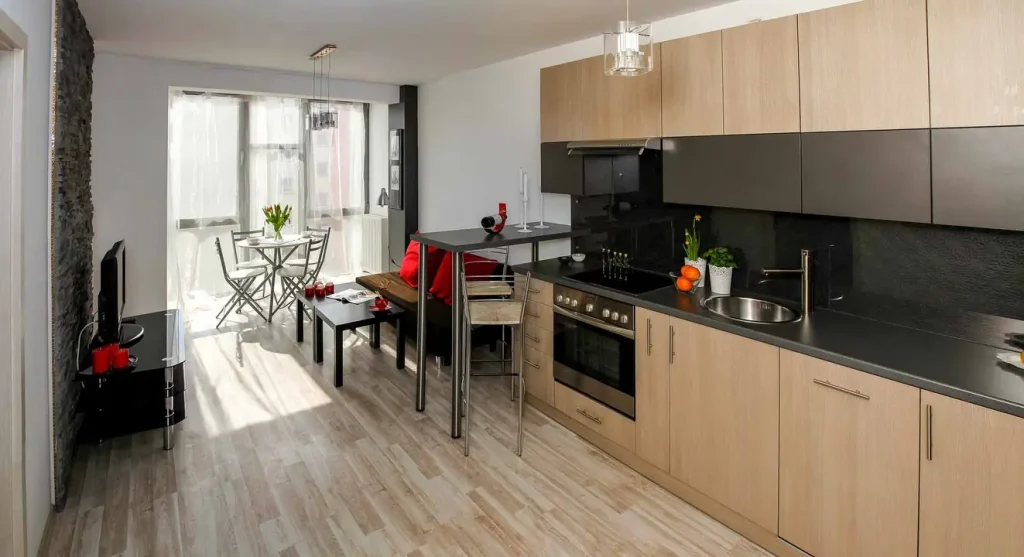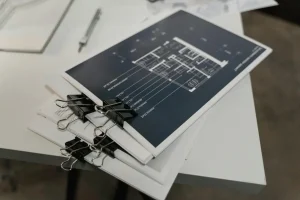
tips to make a small flat feel larger
Living in a small flat can feel like you’re constantly playing a game of human Tetris. I remember my first apartment; it was charmingly described as a “bijou studio,” which is real estate speak for “glorified closet.” Every day was a battle against the encroaching walls. You’d think the only solution is to move, to find more square footage. But that’s not always an option, is it? The real secret, the one that can save your sanity and your deposit, is learning the essential tips to make a small flat feel larger. It’s not about magic; it’s about clever manipulation of space, light, and perception. It’s an art form, really.
Understanding Small Spaces: Why Your Flat Feels Cramped
Before you can fix the problem, you have to understand it. Why does that room, which seemed so promising when you viewed it empty, now feel like a shoebox? It’s not just about the physical dimensions. It’s about how your brain interprets the space around you. And often, we’re our own worst enemies, falling for old habits and bad advice.
The Psychology of Compact Living
Our minds crave openness. A cluttered, poorly lit, or inefficiently arranged space can trigger feelings of anxiety and claustrophobia. It’s a primal thing. When a room is packed with stuff, with no clear pathways, your brain subconsciously registers it as a chaotic or even unsafe environment. There’s no room to breathe, mentally or physically.
The goal isn’t just to cram your life into a smaller box; it’s to create an environment that feels calm, open, and restorative. Truly understanding the core design principles for small space living is the first step toward reclaiming your sanity. This is more than just decorating; it’s about curating a feeling of spaciousness where none seems to exist. So many people overlook this, but it’s foundational to applying any effective space-enhancing techniques.
Common Design Misconceptions
Let’s bust some myths. Someone once told me that in a small flat, every piece of furniture must be miniature. Terrible advice. I tried it, and my living room ended up looking like a doll’s house for giants—utterly ridiculous and not at all comfortable. A few well-chosen, normal-sized pieces often work better than a dozen tiny, ineffective ones. Another common misconception is that you must paint everything brilliant white. While light colours help, a sterile, all-white box can feel just as oppressive as a dark cave. Don’t be afraid of colour! It’s all about where and how you use it. These are just some of the hurdles to overcome when you’re figuring out how to make a small apartment feel bigger. Forget the rigid rules you’ve heard and focus on what actually works for your unique space. The internet is full of generic advice for small flats, but many are based on these outdated ideas.
Mastering Furniture Selection and Layout for Enhanced Space
This is where the real battle is won or lost. Your furniture is the biggest player in the game. The right pieces, arranged thoughtfully, can completely transform a cramped room into a functional and airy-feeling haven. It’s time to think like a chess master, where every piece has a purpose and a perfect position.
Multi-Functional Furniture: A Small Flat’s Best Friend
If a piece of furniture only does one thing, it’s not earning its keep in a small flat. It’s that simple. Think of your home as a tiny, efficient business where every employee (or piece of furniture) needs to be a multi-tasker. That coffee table? It should have hidden storage or lift up to become a dining table. That ottoman? It’s a footrest, extra seating, and a secret hiding place for your clutter. Investing in high-quality, space saving furniture for tiny flats is non-negotiable. I have a bed with huge drawers underneath, and it’s a total game-changer for storing linens and off-season clothes. This kind of practical advice delivers immediate results. So, when considering what furniture makes a small room look larger, the answer is often the pieces that do more, allowing you to have less.
Strategic Placement: Unlocking Hidden Potential
Please, for the love of all that is spacious, stop pushing all your furniture against the walls. It’s a rookie mistake. It creates a weird, empty “dead zone” in the middle of the room and actually makes the space feel smaller and more constrained. Try “floating” your sofa off the wall, even by just a few inches. It creates a sense of airiness and flow.
The key is to create defined zones and clear, walkable pathways. A thoughtful furniture layout for small open plan living can delineate a living area from a dining area without any walls. This strategic approach is one of the most powerful ways to enhance your space. Group furniture into conversational clusters. It’s amazing what a little breathing room can do. Such a simple change, yet it’s one of the most impactful changes I’ve ever implemented.
Maximizing Vertical Space Smartly
When you can’t build out, build up. Your walls are prime real estate, so start using them. Think tall, slender bookcases that draw the eye upward, creating an illusion of height. Floating shelves are your best friend; they provide storage and display space without the visual bulk of a floor unit. Wall-mounted desks, bedside tables, and even TVs can free up precious floor space, making the room feel instantly bigger. These vertical storage solutions for small flats are critical. The more of the floor you can see, the larger the room will feel. This principle is central to any good strategy for a small flat, because it fundamentally changes the room’s perceived dimensions.
The Power of Light and Color: Creating Illusions of Grandeur
Never underestimate the power of illusion. With the right combination of light and colour, you can trick the eye into seeing more space than is actually there. It’s about creating an atmosphere that is bright, airy, and expansive, even if your actual square footage is minimal.
Choosing the Right Color Palette for Small Rooms
Okay, let’s talk paint. While light colours like off-whites, pale greys, and soft blues are a safe bet, they aren’t your only option. The key is cohesion. Using a single, light colour across walls, trim, and even the ceiling can blur the boundaries of a room, making it feel more expansive. But if you love a bold colour, use it! Paint a single accent wall—preferably the one furthest from the entrance—to create a sense of depth. The best paint colors for small rooms to look larger are often those that create a unified, uncluttered visual field. Ultimately, the goal is to make a flat feel larger, not to make it boring. Don’t be afraid to inject your personality into the space.
Harnessing Natural Light Sources
Natural light is liquid gold in a small space. Your number one job is to let as much of it in as possible. That means no heavy, dark, light-sucking drapes. Opt for sheer, gauzy curtains, light-filtering blinds, or just leave your windows bare if privacy allows. A well-placed mirror opposite a window can work wonders, bouncing light around the room and creating an incredible sense of openness. Keep your windows clean! It sounds ridiculously simple, but you’d be surprised how much light a grimy window can block. This is one of the easiest and most effective ways to make a small flat feel larger. Letting the outside in helps to dissolve the room’s physical boundaries.
Innovative Artificial Lighting Techniques
When the sun goes down, your lighting strategy needs to take over. A single, harsh overhead light will create shadows and make your flat feel like a cave. The solution is layered lighting. You need a mix of ambient (general), task (focused), and accent lighting. Use floor lamps and wall sconces to draw light upwards and away from the floor. Good lighting ideas for compact living areas include placing uplighters in corners to make the ceiling feel higher or using LED strips under cabinets to create a floating effect. Strategic lighting is absolutely one of the most transformative tricks for a small flat, especially when you need to maximize space in a studio apartment where one room serves all functions.
Decluttering and Organizing: Your Foundation for Spaciousness
You can have the perfect furniture and the best colour palette in the world, but if your flat is buried under a mountain of stuff, it will always feel small. Always. Decluttering is not just a task; it’s a mindset. It is the absolute, non-negotiable foundation for everything else.
Adopting a Minimalist Mindset
Minimalism isn’t about living in a cold, empty white box. It’s about being intentional. It means curating your possessions so that you are only surrounded by things you truly need, use, or love. The “one in, one out” rule is a great place to start. Every time you bring something new home, something else has to go. Learning how to declutter a small living space is a continuous process, not a one-time fix. It’s about breaking the habit of accumulation. These minimalist decorating small apartment ideas aren’t about deprivation; they’re about freedom from the weight of too much stuff. Embracing this is one of the most life-changing habits for a small home.
Clever Storage Solutions for Every Corner
Once you’ve pared down your possessions, you need to find a smart home for everything that remains. This is where you get creative. Use the space under your bed, inside your sofa, and over your doors. My greatest discovery was a set of magnetic racks for spices that now live on the side of my fridge, freeing up an entire kitchen cabinet. You need clever storage solutions for small apartments. Think slim rolling carts for tiny bathroom gaps, hanging organizers for shoes and accessories, and vacuum-sealed bags for bulky bedding. Every forgotten nook and cranny is an opportunity. Finding these hidden spaces is a core part of maximizing a small space.
Maintaining Order in a Compact Home
The hard truth? A small home gets messy faster. There’s just nowhere to hide the chaos. The key is to build small, consistent habits. Spend 10 minutes every evening doing a quick reset: put things back where they belong, wipe down surfaces, and fluff the cushions. Make your bed every single morning. It instantly makes a small bedroom look more put-together. Staying organized isn’t a massive project; it’s a series of tiny, manageable actions that prevent clutter from taking over. This discipline is the secret ingredient to making a small space feel larger.
Decorating Tricks: Mirrors, Art, and Greenery for Visual Expansion
With the foundations of furniture, light, and organization in place, you can now add the decorative layers that will enhance the illusion of space. These are the finishing touches, the clever tricks that fool the eye and delight the senses.
The Strategic Use of Mirrors
This is the oldest trick in the book for a reason: it works. Mirrors are magic. They reflect light, they reflect the view, and they create a profound illusion of depth. Using mirrors to make a room feel bigger is a classic for a reason. But don’t just hang one anywhere. For maximum effect, place a large mirror directly opposite a window to double your natural light and create a “second window.” A wall of mirrored closet doors can make a small bedroom feel twice its size. One large, statement mirror is often more effective than a collection of smaller ones, as it creates a single, unbroken vista. This might be the most famous trick for making a space feel larger, but its power should not be underestimated.
Art Placement for Depth and Perspective
Just like with furniture, don’t fall into the “small art for a small room” trap. A single, large-scale piece of art can act as a powerful focal point and make a wall feel bigger and more important. It commands attention and expands the visual space. Conversely, a gallery wall of tiny frames can look cluttered and chaotic. When hanging art, place it slightly higher than you normally would to draw the eye upward. Art that depicts landscapes or has a strong sense of perspective can also add a feeling of depth. These are the nuanced details that make a space feel larger that elevate a space from functional to beautiful.
Bringing Nature In: Plants for Small Spaces
Plants breathe life into a room, literally and figuratively. They add colour, texture, and a sense of vitality that can make a sterile space feel like a home. For small flats, choose plants that grow vertically rather than horizontally. A tall snake plant or a fiddle leaf fig can add height and drama without eating up floor space. Hanging planters are another brilliant solution, drawing the eye up and adding a layer of decoration without using any surfaces. Even a few small succulents on a windowsill can make a difference. Incorporating greenery is a refreshing part of any collection of small flat decorating ideas to maximize space and is a refreshing way to maximize your space.
Flooring and Window Treatments: Unifying Elements for a Larger Feel
Finally, don’t neglect what’s under your feet and on your windows. These elements frame your entire space and can either unify it, making it feel cohesive and large, or chop it up, making it feel disjointed and small.
Flooring Options that Enhance Openness
If you have the choice, using a single type of flooring throughout the entire flat will create a seamless, uninterrupted flow that dramatically enhances the sense of space. Light-coloured wood, laminate, or tile is ideal. If you’re laying planks, orient them to run along the longest dimension of the room to elongate it even further. Rugs are great for defining zones, but choose wisely. A small, postage-stamp rug will visually shrink the floor. Instead, opt for a larger rug that most of the furniture can sit on. This anchors the space and makes it feel more generous. These are often overlooked advice for small flats.
Smart Window Dressing for Small Flats
Your window treatments should be simple and functional. Mount your curtain rod as high and wide as possible—several inches above and beyond the window frame. This tricks the eye into thinking the window is much larger than it is. Let the curtains hang straight down to the floor. Use lightweight, light-coloured fabrics. Knowing how to use curtains in a small apartment is a simple skill with a big payoff. By implementing this kind of advice, you’re not just decorating; you’re re-engineering your home to be its best, most spacious-feeling self. And that’s a space you’ll love to live in.






